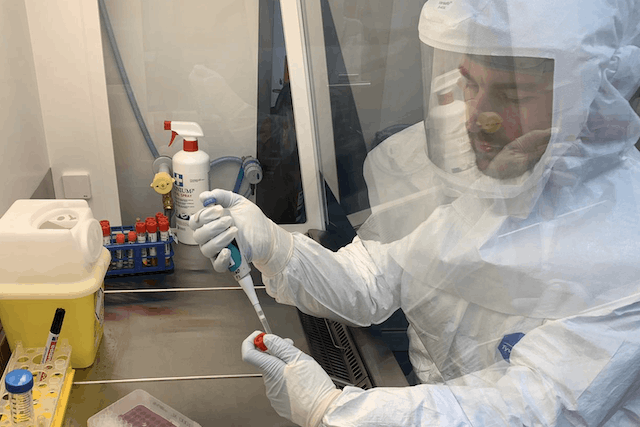Jess Bauldry: How many tests has the LNS conducted so far (as of 16 March 2020)?
Prof Friedrich Mühlschlegel: The disease became apparent in December 2019. The virus was isolated and identified in January 2020. The first test protocol was established. We ran our first test 29 January. Since then we’ve conducted 660 tests at the LNS with a total of 42 positives.
Not all of them were requested in Luxembourg. I would say a small number of tests we also did at short notice for some neighbouring hospitals which were in the process of setting up testing and validation procedures. But the vast majority of these 660 tests are of course from within Luxembourg.
JB: How is testing being coordinated in Luxembourg and what is the process afterwards?
FM: The test requesting and organisation is run by the public health authorities. In this case it’s the Inspection Sanitaire, part of the Direction de la Santé. They then execute processes, and coordinate the test taking for example […] but also we’re in constant contact with them. Literally in real-time contact.
JB: What happens to the sample?
FM: The test […] is the nasopharyngeal swab of the nose or throat. That probe is then sealed and packaged in a safe box. The box is transported to the LNS. An individual receives the box. In that swab there’s the potential of an infectious virus. One of the first procedures for the safety of the staff, is that the virus or probe is inactivated in a biosafety level 3 laboratory. That means there’s no more infectious virus in that probe. From that moment on the standard molecular biology techniques spring into action. We determine whether there’s a virus in the specimen or not.
JB: Private laboratories in Luxembourg are also now offering the test for individuals with a prescription. Can you tell me how you’re working together for that?
FM: That came last week. Previously our team and I met with directors of the private labs. There’s a really good atmosphere and understanding that on the principle we will manage this together. The basis is the same procedure i.e. detection of the virus’ genetic information. What’s important, and this is quite relevant, is that tests are validated. What we also want to avoid is that we all focus on a single test. Let’s say from a single manufacturer then suddenly we run into a stock availability issue.

LNS director Prof Friedrich Mühlschlegel, pictured, considers it too early to speculate about different virus strains. Photo: LNS
JB: How many different kits or products does the LNS currently use?
FM: We have validated five products and are in the process of validating a sixth. I think there will be more and more coming.
JB: What are the validation procedures for these tests?
FM: We established the test in a lab with different controls […] to make sure that the tests works in the real world. What we define as a positive and negative is validated or cross-checked by another lab. We’ve done it with the reference centre in Rotterdam, very quickly and efficiently using night transport. Now that we’ve done the complete validation [testing the first 5 positives and 10 negatives] then of course we will help [private] clinics in the process of being validated.
JB: How long does it take to get a result?
FM: Five hours.
JB: How many LNS staff are working on testing covid-19 samples at the LNS?
FM: The entire microbiology department counts 30 staff, of which six [increased to 10 last week] are involved in covid-19 response. We’ve been preparing and we’re training staff in order to expand that expertise and that pool. And we’ve been preparing for a greater degree of automation.
JB: Are they working overtime right now?
FM: Everybody is working overtime. The LNS set up two test runs in order to accommodate samples coming in and be able to release results so individuals can act on them. They had two runs per day during the business week then there’s activity at the weekends as well. Don’t forget the first cases came up over a weekend. We’ve one run at the weekend. There are two people minimum at the weekend.
JB: What prevents Luxembourg from running wider scale testing on residents, similar to the nationwide testing carried out in Iceland?
FM: One needs to reflect carefully on the clinical value of mass screening in light of social distancing measures. Is it in line to protect those who are most at risk? One also needs to take into consideration appropriate utilisation of resource and testing capacity and should not risk exhausting resources. Is it not better to focus more on risk group testing. Luxembourg is an international hub at the center of Europe. Importantly, and differently to Iceland, there is a large number of professionals that commute from neighbouring countries on a daily basis so it is a highly dynamic population. Finally does the approach reflect the biology and progression of the infection and thus fulfil the purpose? We have to continue on strong measures of infection control and prevention.
JB: What work is the LNS doing to better understand the virus and disease?
FN: As an institution we’ve a responsibility towards increasing the science behind this outbreak. We started speaking, collaborating with scientific institutions, like the Luxembourg Institute of Health, the universities, the hospitals, of course and of course always with the ethical framework. That’s very important.
JB: Have you observed any variations in the virus’ you’ve detected at the LNS?
FN: It’s way too early to say or to speculate. I think the scientific evidence base is emerging as we speak.
